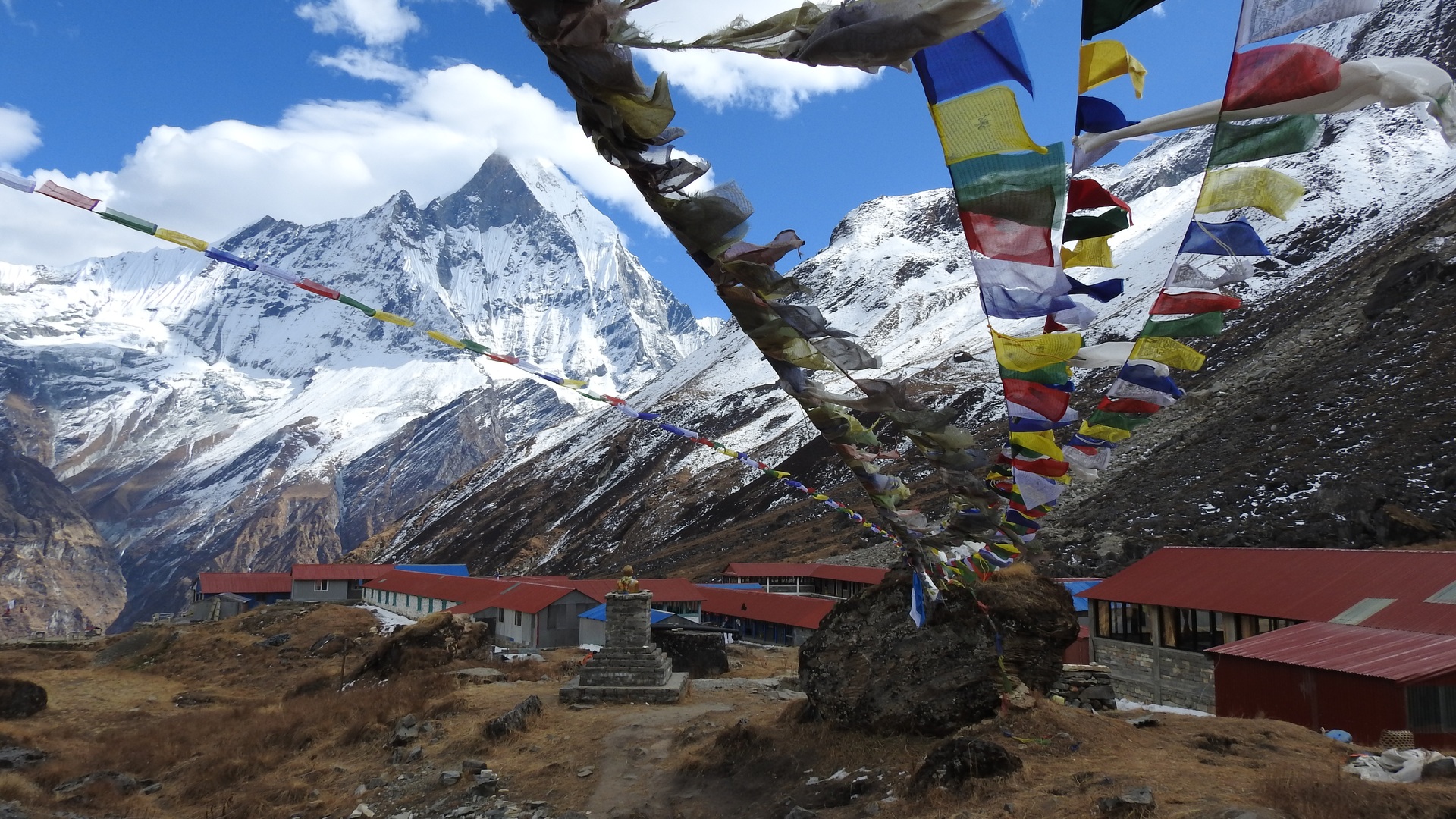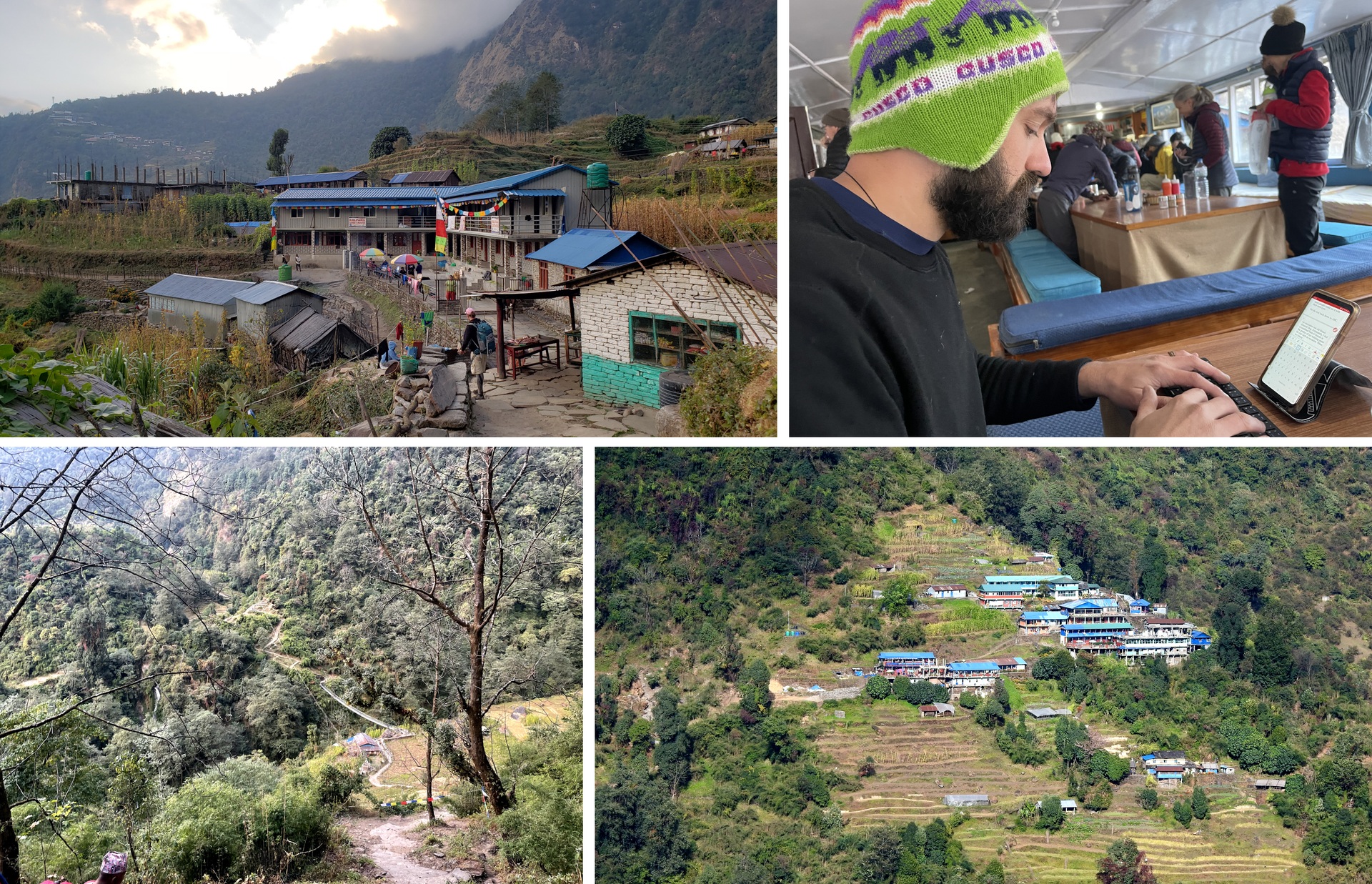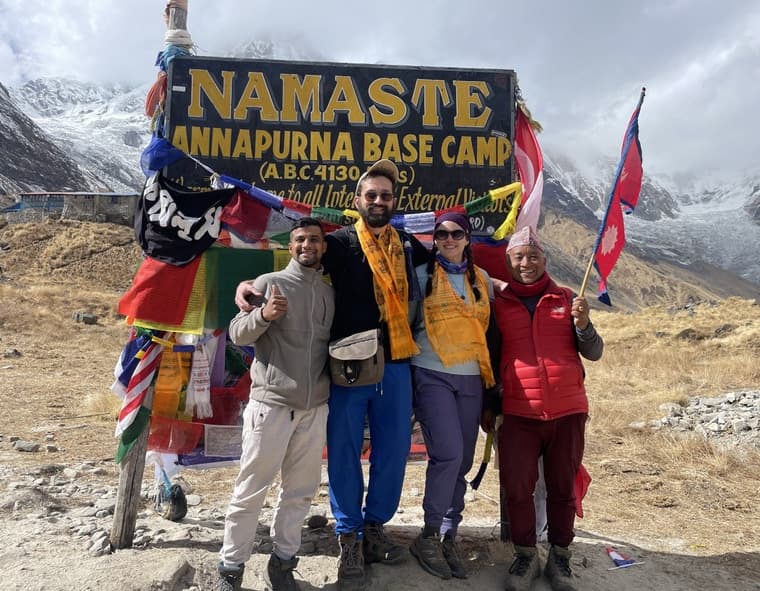In a thousand ages of the gods, I could not tell thee of the glories of Himachal.”
-Valmiki, Sanskrit poet

Watching the sun break across the face of Annapurna South and Annapurna I is nothing short of spectacular, and it’s a sight that sears itself with alacrity into my memories of trekking in Nepal. This is a jaw-dropping display of light and shadow—but it doesn’t happen all at once. As dawn approaches, the sun remains invisible somewhere behind the massif of Machapuchare. Its first rays touch only the summits of Annapurna South and Annapurna I, casting a faint blush onto the delicate crenellations of their glaciated peaks. Gradually, the whole of the mountains are cast in the forge of the sun's full light, and they seem to burn from inside with an impossible golden fire. This is what we’ve come here to see: this is why one makes the arduous trek to Annapurna Base Camp.
As we stand enraptured by the undiminished splendor of raw nature, we reflect upon the holy mountain amphitheatre that is the Annapurna Sanctuary. This is a historically sacred place: the abode of gods and the home of untold treasures. Certain religious prohibitions are observed here even today, Hari explains. Once you enter the Sanctuary, you’ll find only vegetarian choices on the menus of guesthouse restaurants. That’s because meat is prohibited here—and the consequences for violating this rule can be severe. Hari tells us a story about a group of Korean trekkers who once brought pork into Annapurna Base Camp. They were rewarded with heavy snow, intense winds, and dangerous avalanches. I frown to myself—I don’t eat meat, but I’ve been ordering plenty of fried rice with egg at the lodge. But it turns out that I needn’t worry. “Eggs are okay,” Hari reassures us.
When the sun has fully risen and we’ve wolfed down a quick breakfast, it’s time to bid a fond farewell to Annapurna Base Camp and begin our return journey. We’ve chosen to set an ambitious goal for the day’s hike: we were so enchanted by the little village of Chhomrong that we’ve decided to see if we can make it that far in a single day. It’ll be a serious achievement, if we can pull it off. Chhomrong lies more than 13 miles from ABC, and while that may not sound like much, we already know that today’s route will mean climbing a lot of stairs. Even with the highest mountains at our back, this is steep country, full of alternating ascents and descents. But the temperature is cool, the air is crisp, and the mountain views are stupendous—I’m feeling full of life and vigor, capable of achieving anything.

A few hours later, I wonder what we were thinking: this sure is a lot of ground to cover. Fortunately, retracing our steps allows time for reflection. I’m no longer worried about obsessively documenting every twist and turn of the trail with photographs, having already traveled this way over the course of the past few days. This affords a certain freedom for introspection, and we settle into a comfortable-but-quiet rhythm, each of us content to ply the trail accompanied by our own internal monologues. For my part, I find myself thinking of a passage from Tolkien:
Still 'round the corner there may wait
A new road or secret gate;
And though I oft have passed them by,
A day will come at last when I
Shall take the hidden paths that run
West of the Moon, East of the Sun.
While the Annapurna Base Camp Trek is, by-and-large, a single trail with very few offshoots, there are a few secret paths which meander into the rhododendron forests, disappearing around a corner. They leave me wondering where they might lead, and I feel a pang of regret when I realize that I’ll never know. Sangkhar, at least, cleverly uses a few of them as shortcuts, disappearing from behind us and reappearing twenty minutes later to lounge on the trailside and grin as we catch up with labored breath. And so the day goes: aside from a brief stop for lunch at Dovan, we knuckle under our backpacks and make double-time all the way to Chhomrong.
We pull into Chhomrong after about ten hours on the trail. Dusk is closing in around us, and fog rolls in from over the mountains. Across the valley, Lower Sinuwa twinkles with lights pushing back the darkness, and our path ahead is lit only by the faint glow of lamps from guesthouse windows. We past first one woman still working in the terraced fields of the village, then another, Each of them asks Hari how far we've come that has us arriving so late, and each is surprised to hear that we've come all the way from Annapurna Base Camp in a single day. So am I.

For dinner, we order two big plates of dal bhat. Expecting that walking 13 miles would've made us ravenous, we're counting on the all-you-can-eat nature of that classic Nepali dish. While we wait for our meals to arrive, we enjoy a few beers and play dhumbal in the teahouse dining room. Emboldened by good cheer, I order a mug of raksi to pass around: a local alcoholic brew that tastes simultaneously of smoke and citrus. I realize that despite a hearty lunch of fried rice, I must have burned off everything I ate to this point—because the combination of beer and raksi is rapidly taking effect.
Dinner soon arrives to soak up the alcohol, and it's a delight: flavorful curry, bottomless dal, and a spicy chili sauce on the side. I'm particularly excited about the latter; as a lover of hot food, I've found little in the mountains to really test my mettle and make me sweat. But this does the trick, and the heat complements the dal bhat to create one of the most memorable meals I've had the Himalayas. But much to our surprise, neither Krista nor I have any appetite for a second plate: the long hike has tired us out, and we’re soon off to bed. We do, however, find an extra square inch to enjoy dessert: a high-altitude slide of apple pie. It’s considered a local specialty, and it hits the spot.



